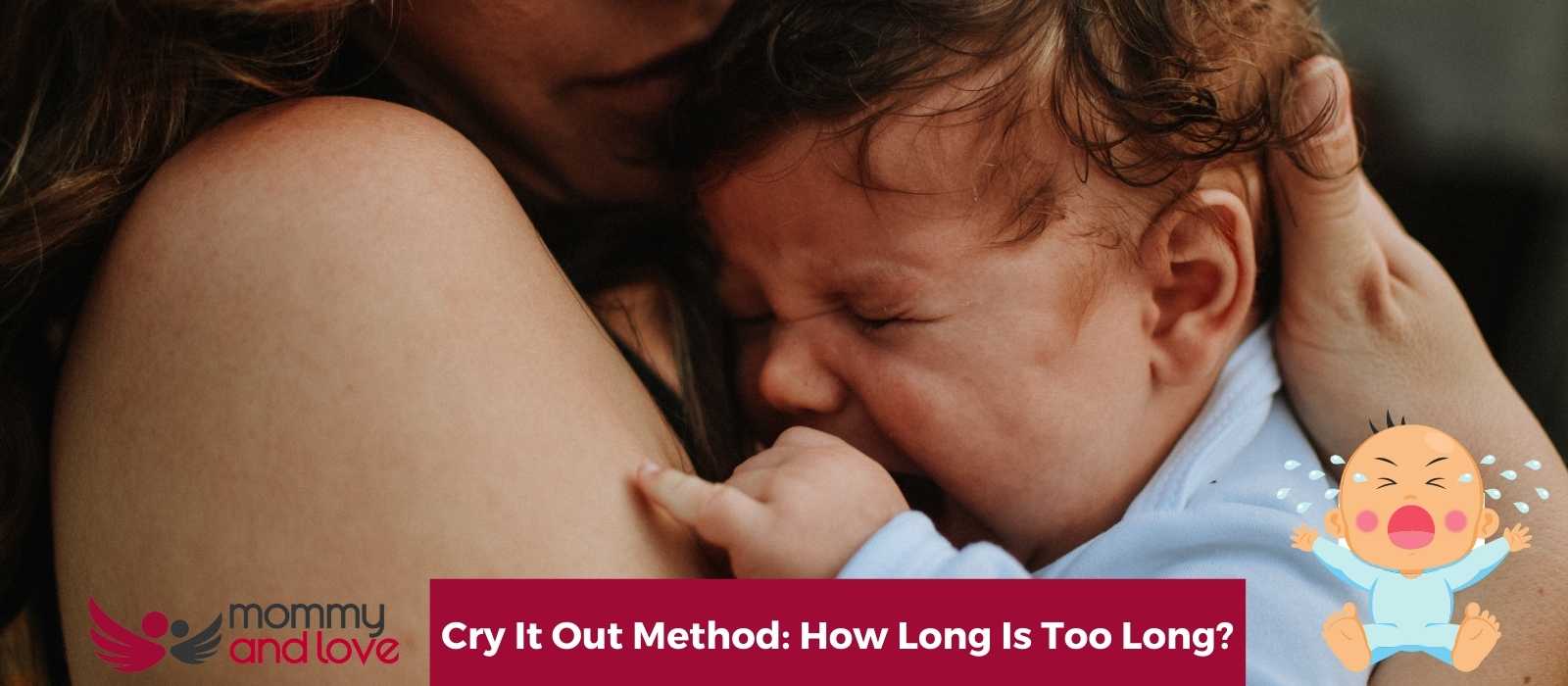The Cry It Out or CIO method is a sleep training technique where you let your baby cry for a predetermined amount of time before going in to comfort them.
The goal of the cry it out method is to let the baby work herself to sleep by crying. In the beginning, you may have to let your baby cry for 5 minutes up to 30 minutes before she falls asleep. Every baby is different, so the amount of time it takes for your baby to fall asleep may vary.
Affiliate Disclaimer: As an Affiliate, we earn from qualifying purchases.
What Is the Cry It Out Sleep Training Method?
The cry-it-out sleep training method sometimes called controlled crying or extinction method is a popular method of sleep training that involves letting baby cry for a set period of time before responding to them.
This method is often used by parents who are struggling to get their babies to have a nighttime sleep, teach them how to self-soothe which is an essential skill, and help them sleep through the night. Usually, you will see some results about a week after starting the sleep training.
The training can last a few days for up to a few weeks. Even though there’s no time limit, you may want to consider switching to a different approach if you don’t see any positive results.
As with any other sleep coaching, CIO doesn’t teach a baby to sleep through the entire night without feeding. It simply teaches them to fall back asleep whenever they wake up at night.
Does the Cry It Out Method Help Babies Fall Asleep?
Babies are generally developmentally ready to learn how to self-soothe and fall asleep on their own at age 4-6 months. Knowing how to self-soothe helps bottle-fed and breastfed infants to fall back asleep every after night feed.
Some parents find success in sleep training their babies with the cry it out method. However, other parents that can’t stand the idea of letting their babies cry it out have chosen other sleep training methods that involve less crying.
Most parents implementing the crying it out method find their babies cry increasingly less over the first few three or four nights. Eventually, babies cry even fewer tears during the fourth and seventh nights.
There is no right or wrong answer when it comes to sleep training your baby. It’s a personal decision that you’ll need to make based on your style, what you feel comfortable with and your baby’s temperament. Additionally, other factors such as acid reflux, ear infection, and changes to the sleeping environment may affect sleep coaching.
If you’re considering the cry it out method, it’s important to do your research and be prepared for some tough nights. But if you’re willing to stick it out, it could be an effective way to get your baby to sleep through the night.
How Do I Sleep Train My Baby With the Cry It Out Method?
If you have already decided to go the cry it out route to sleep train your baby, here are a few things you can do:
Establish a Predictable Bedtime Routine.

This means having a set bedtime and sleep habits and sticking to them as closely as possible.
A good bedtime routine should include a bath, final feeding, snuggling her favorite stuffed animals during storytime, some quiet time for your child to wind down, and maybe a massage as your baby sleeps.
However, the routine should not involve feeding or rocking the baby in a rocking chair to sleep because these are considered negative sleep associations.
A consistent bedtime routine also helps the sleep-trained baby wind down for the night and get better sleep. This can help them to understand that they need to start preparing for sleep and make it easier for them to fall asleep when it is time to do so.
Having a set bedtime also makes it easier to stick to a sleep schedule, which can further help your child to get the sleep they need.
If your child is resistant to going to bed at first, that’s ok. Stick with the routine and eventually, they will come to accept it.
Pay Attention to Your Baby’s Sleep Cues.
Paying close attention to the baby’s cues that she’s tired or ready to sleep is important for sleep training success. By understanding when the baby is tired, parents can help their child wind down and get ready for sleep. This way, parents can avoid putting their babies down when they are still wide awake and full of energy.
Additionally, overlooking these sleep cues and she’s overtired, she’ll have a hard time falling asleep because stress hormone is flooding in her bloodstream.
There are several signs that parents can look for to know when their baby is ready for sleep, such as:
- rubbing their eyes
- constantly yawning
- getting fussy or cranky
- pulling on their earlobes
If parents can learn to recognize these cues, they can help their baby fall asleep more easily and with less crying.
Make Your Baby’s Room a Safe, Conducive Sleeping Environment.

It is important to create a safe sleep environment for your baby. This means making sure the room is free from potential hazards that could harm your baby.
Here are some tips on how to create a safe sleep environment for your baby:
- Remove all potential hazards from the room. This includes sharp edges on furniture, choking hazards on the floor, and anything else that could potentially hurt your baby.
- Make sure the room is dark and quiet. This will help your baby to get the best sleep possible.
- Keep the room at a comfortable temperature. This will ensure that your baby is comfortable and can sleep peacefully. Use a thermometer to check the room temperature before putting your baby down for a nap or nighttime sleep.
- Make sure the crib is in a safe location. This means placing it away from windows, doors, and any other potential hazards.
- Follow the manufacturer’s instructions when setting up the crib. This will ensure that it is assembled correctly and is safe for your baby to use.
Put Your Baby Down Awake, but Drowsy.

The crying it out method is not only about letting your baby cry but it also involves putting the baby down in the crib fully awake but drowsy, they are still alert enough to know that they are in their bed and not in your arms.
This helps them to understand that it is time to go to sleep and not time to play. Let your baby fuss until she’s already falling asleep.
It may take a few nights for them to get used to this new routine, but eventually, they will learn how to self-soothe and fall asleep on their own without needing you to rock them or feed them sleep.
Know That Not All Cries Require Immediate Attention.
It can be difficult to know how to respond to a crying baby, especially when it comes to sleep training. However, it is important to remember that not all cries require immediate attention.
For parents who are sleep training their babies using the cry-it-out method, this means that it is best to keep responses short such as a gentle pat when the baby cries to avoid overwhelming the baby or causing them to cry harder. Most babies may cry for a few minutes or simply quietly fall asleep.
You will also find it easier if you set a max crying time. For instance, you set a 10-minute wait before responding to your baby’s crying. If you’re not around, inform a family member that you are training your baby and about how long should they wait to respond.
This knowledge can help parents feel more confident in their decision to implement the cry it out method, knowing that they are not neglecting their child’s needs. Remember that this method calls for you to let your baby cry until the crying virtually ends and she falls asleep.
Yes, your baby may simply fuss but most of the time she will stop crying and sleep in her crib.
How Long Should You Let the Baby Cry It Out During Sleep Training?
The amount of time that is too long for a baby to cry it out during sleep training will vary. This variation is due to different babies’ ages and individual needs. Most parents let their babies cry it out for 5 minutes to half an hour before responding and soothing them.
How long you let your baby cry it out entirely depends on you and your parenting style. And whatever you decide, it is important to be consistent when using the cry it out method, and know that eventually, your patience will pay off and both you and your baby will have a better night’s sleep.
Conclusion on How Long Is Too Long for the Cry It Out Method
It’s important to know that responding too quickly to your baby’s cries could result in them not being able to soothe themselves while waiting too long could make them more upset. It usually depends on your style as well as your baby’s age. And by understanding these guidelines, you can better comfort and care for your child.
Sleep training is not an easy process, but it is worth it in the end. You will be able to get more sleep and your baby will learn how to soothe themselves to sleep. Be consistent with the method you are using and do not give in. If you follow these tips, you will see positive results in no time.
FAQs on Letting the Baby Cry It Out
Should You Let the Baby Cry Out for Naps?
Naps are an important part of a baby’s day, and letting them cry out for naps or daytime sleep can be an effective way to lengthen their nap time. It may seem counterintuitive, but crying can actually help babies sleep better.
Crying is a form of self-soothing, and it helps babies release any built-up energy or frustration. It also signals to the body that it’s time to wind down and prepare for sleep. As a result, crying can actually help babies sleep better and for longer periods of time.
What Is the Difference Between the Cry It Out Method and the Ferber Method?
The Cry It Out method, also known as CIO, involves letting your baby cry until they eventually fall asleep. The Ferber method is a form of cry-it-out sleep training that allows parents to gradually let their baby cry for shorter periods of time before responding. There are other ways of getting baby sleep trained that do not involve crying it out.
How to Respond if Your Baby Spits Up or Throws Up When Crying It Out?
If your baby occasionally spits up or throws up while crying it out, don’t worry. It’s perfectly normal and nothing to be concerned about. However, it could mean that this particular sleep training method is not for your baby and it may be time to try a different approach.

This article was written by: Gian MIller – Full-Time Writer, Baby Whisperer & Dad of 3.
Gian spends a lot of his time writing. A self-proclaimed baby whisperer, Gian has been through it all with his own children and is passionate about sharing his hard-won wisdom with other parents. When he’s not writing or changing diapers, you can find him playing the guitar or watching baseball (or preferably both at the same time).




